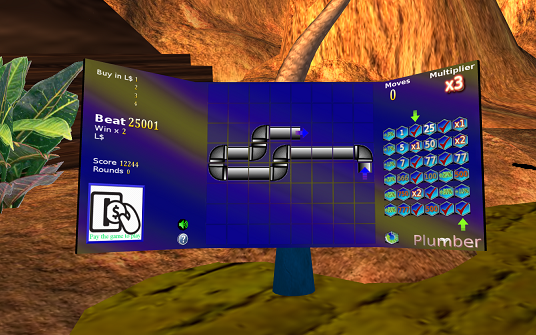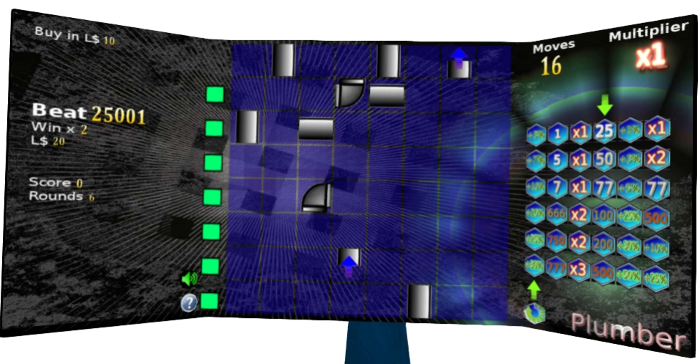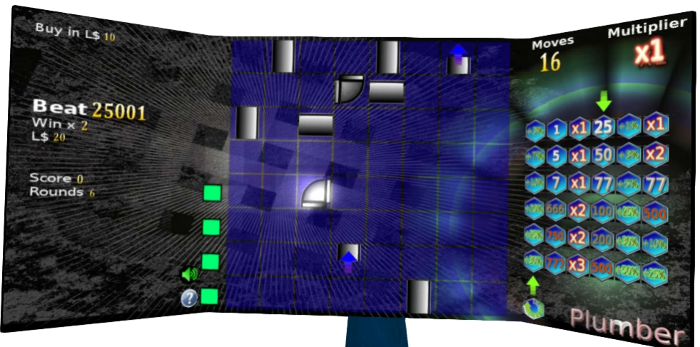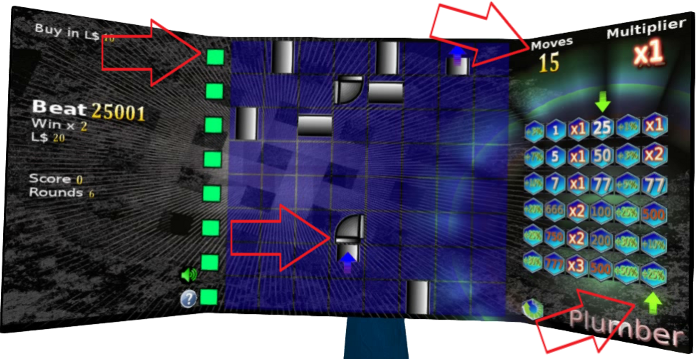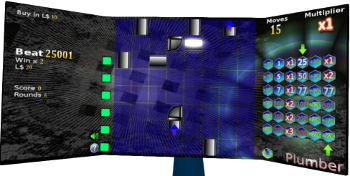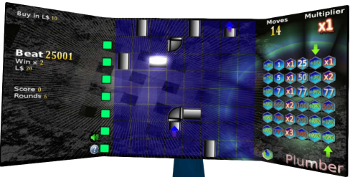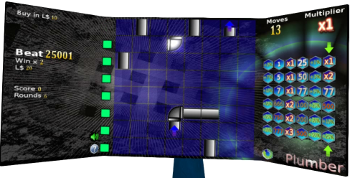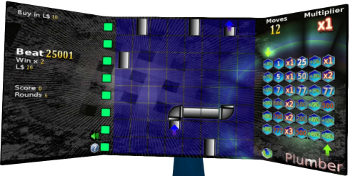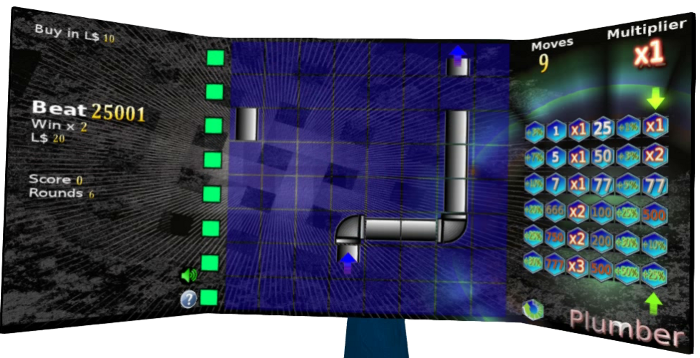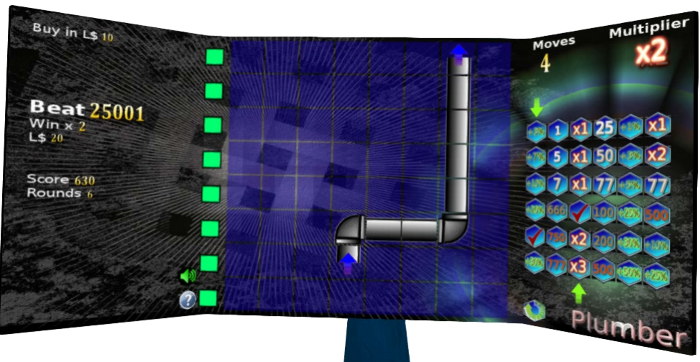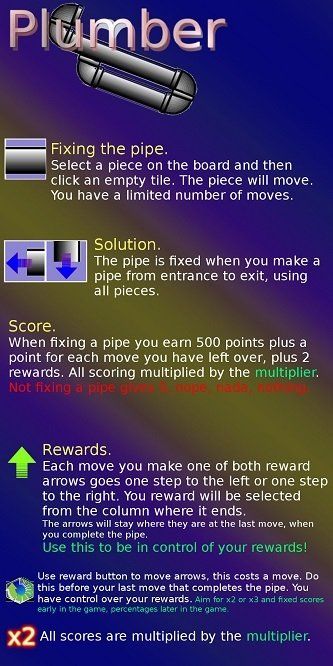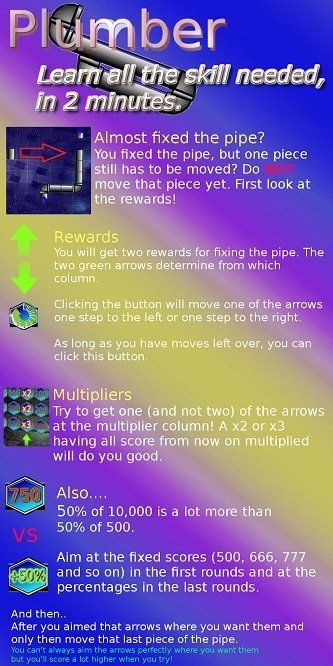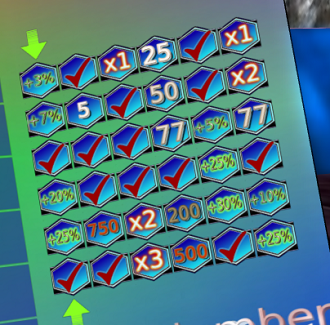How to play
Plumber
Plumber is a skill game where you play a plumber. You do what plumbers do: You fix pipes. Fixing a pipe is a sort of puzzle, you got a limited number of moves to fix the pipe. Once you did fix the pipe you will receive points:
– 500 points because you fixed a pipe,
– 1 point for each move you have left over
– 2 rewards. These will be discussed in great detail later on.
All score will be multiplied by the applicable multiplier, being x1, x2 or x3.
You will get 7 rounds, each round you have to fix a pipe. Some pipes are tougher than others, the longer the pipe, the more moves you got to fix it. (The number of moves you get is 2 times the number pipe parts) In general the pipes get longer in the later rounds of the game.
– 500 points because you fixed a pipe,
– 1 point for each move you have left over
– 2 rewards. These will be discussed in great detail later on.
All score will be multiplied by the applicable multiplier, being x1, x2 or x3.
You will get 7 rounds, each round you have to fix a pipe. Some pipes are tougher than others, the longer the pipe, the more moves you got to fix it. (The number of moves you get is 2 times the number pipe parts) In general the pipes get longer in the later rounds of the game.
If you fix the pipe, you’ll receive points and rewards. You didn’t fix the pipe? Sorry, but we won’t pay a plumber that doesn’t fix pipes. You score 0 this round. Try again next round!
Fixing these pipes isn’t too hard. Sure you will fail some when you are new to the game. Practice some on freeplay or low cost machines.
That’s all it takes, it is puzzling, you’ll get good at it.
That’s all it takes, it is puzzling, you’ll get good at it.
You start a game by paying the game machine. Unless it is a freeplay game, then touch the game machine and choose play in the menu that will pop up.
The game starts with giving you a pipe to fix. You also see a time indicator in the form of green dots. You have 16 seconds to make a move. Do make a move on time, or this round will end and you will gain 0 points for it. You make a move by selecting a part of the pipe and then clicking an empty tile on the board.
Your goal is to connect the begin and end part of the pipe, using all pipe parts. This will give you two rewards. You have limited moves available to complete this task.
The begin and end part themselves cannot be moved.
The begin and end part themselves cannot be moved.
Let’s see how the game works, by playing it.
I pay the game to start it. The game starts immediately, giving me a first pipe to fix. At the left side of the game machine we see that I paid L$10, I must beat the score of 25001 (that’s just a testing score we put to make this demo) in order to win L$20, my current score is 0 and I have still 6 rounds to go after the current round.
At the right side you see near the top of the game machine that I have 16 moves to go this round and that the multiplier is x1. Below that you see the reward plate. At the reward plate I can determine the rewards I’ll earn for fixing the pipe. We get into that a bit further.
That I have 16 moves is no coincidence. There are 8 movable pieces on the play board on the middle of the game machine. The number of moves is always 2 times the number of movable pieces. The average number of pieces that a pipe contais grows with every round. (The pipe contains between 6 to 10 pieces plus one for every round).
The first thing I have to do is fixing the pipe. Without a fixed pipe, no score will be gained this round.
I pay the game to start it. The game starts immediately, giving me a first pipe to fix. At the left side of the game machine we see that I paid L$10, I must beat the score of 25001 (that’s just a testing score we put to make this demo) in order to win L$20, my current score is 0 and I have still 6 rounds to go after the current round.
At the right side you see near the top of the game machine that I have 16 moves to go this round and that the multiplier is x1. Below that you see the reward plate. At the reward plate I can determine the rewards I’ll earn for fixing the pipe. We get into that a bit further.
That I have 16 moves is no coincidence. There are 8 movable pieces on the play board on the middle of the game machine. The number of moves is always 2 times the number of movable pieces. The average number of pieces that a pipe contais grows with every round. (The pipe contains between 6 to 10 pieces plus one for every round).
The first thing I have to do is fixing the pipe. Without a fixed pipe, no score will be gained this round.
As you see in the picture above, I selected one part, by clicking it. Near the middle of the board, the selected part is highlighted. Now I can select an empty tile on the play board and move that part there, by clicking that tile.
In case I accidentally selected another part than I wanted to select, I can still change the selection, by clicking another part, this does not cost a move.
In case I accidentally selected another part than I wanted to select, I can still change the selection, by clicking another part, this does not cost a move.
I click the tile where I want to move the part to. Now 4 things happen, you see them marked with a red arrow in the picture above. From left to right:
* The remaining time indicator goes to the maximum, giving me 16 new seconds for the next move.
* The part is moved to the location where I clicked.
* The amount of remaining moves is decreased by 1.
* One of the green arrows at the reward plate changes position.
You might have expected the first 3 from happening, but what is that green arrow?
Every move you make except the move that completes the pipe, one of both green arrows will change position, either one column to the left or one column to the right. When moving to the left on the left most column, it comes back at the right most column and vice versa.
Once you completed the pipe you will gain 500 points and each of the arrows will give you a reward. This reward is picked from the column the arrow points at. The top arrow first and then the bottom arrow.
Let’s ignore the arrows a bit for now. We first have a pipe to complete.
* The remaining time indicator goes to the maximum, giving me 16 new seconds for the next move.
* The part is moved to the location where I clicked.
* The amount of remaining moves is decreased by 1.
* One of the green arrows at the reward plate changes position.
You might have expected the first 3 from happening, but what is that green arrow?
Every move you make except the move that completes the pipe, one of both green arrows will change position, either one column to the left or one column to the right. When moving to the left on the left most column, it comes back at the right most column and vice versa.
Once you completed the pipe you will gain 500 points and each of the arrows will give you a reward. This reward is picked from the column the arrow points at. The top arrow first and then the bottom arrow.
Let’s ignore the arrows a bit for now. We first have a pipe to complete.
I need to move one more part and the pipe is complete.
Completing the pipe will give me 500 points plus 1 point for each move left over, plus two rewards picked from the reward board. One reward will be picked from the column the arrow above the board points at, and one will be picked from the column the arrow below the board points at.
Both arrows point now to the last column. I don’t like that. I would prefer other columns. I still have 9 moves left. I can move the last remaining part to a different tile on the board, being not the one tile where it would complete the pipe, and then the arrows will move. Perhaps I got a better deal. With 9 moves left, I’ll have 8 shots. (The last move I need to complete the pipe)
Moving that part around until I like the position of the arrows (or run out of moves) is a bit dull. So, the game has a special button for it. Clicking this button moves the reward arrows, costs you a move, but the parts on the play board remain what it is.
This button does not do anything when there is only one move left. The last move, you’ll have to move a part. This so you don’t accidentally click this button one time too much, loosing your round.
This button does not do anything when there is only one move left. The last move, you’ll have to move a part. This so you don’t accidentally click this button one time too much, loosing your round.
A few clicks on that button later, I find the positions of the arrows a whole lot better.
I can move the last part on it’s place, fix the pipe and receive 500 + 4 points, plus two rewards. The top arrow is at a column giving rewards as a percentage, so I get a percentage over my total score until now as a reward. The bottom arrow is at a column giving rewards as a multiplier. If I get x2, then the multiplier changes to x2, making that all score made from that moment on will be multiplied by 2.
It would have been better if the top arrow was one column further to the right. That column gives a reward as a number of fixed points. Whatever percentage I will get, it is a percentage over a score of only 504. So, I won’t get more that at best 30% of 504 = 151 points. The next column has a 50% odd to get a whole lot more, 666, 750 or 777 points.
But, if I make another move, it could also be the bottom arrow moving. Then I have only 3 moves left, so it might not get back at where it is now. Having one arrow at the column giving multipliers is great, doubling or tripling all future score can be very attractive.
I’ll fix the pipe. Let’s see what we get.
I can move the last part on it’s place, fix the pipe and receive 500 + 4 points, plus two rewards. The top arrow is at a column giving rewards as a percentage, so I get a percentage over my total score until now as a reward. The bottom arrow is at a column giving rewards as a multiplier. If I get x2, then the multiplier changes to x2, making that all score made from that moment on will be multiplied by 2.
It would have been better if the top arrow was one column further to the right. That column gives a reward as a number of fixed points. Whatever percentage I will get, it is a percentage over a score of only 504. So, I won’t get more that at best 30% of 504 = 151 points. The next column has a 50% odd to get a whole lot more, 666, 750 or 777 points.
But, if I make another move, it could also be the bottom arrow moving. Then I have only 3 moves left, so it might not get back at where it is now. Having one arrow at the column giving multipliers is great, doubling or tripling all future score can be very attractive.
I’ll fix the pipe. Let’s see what we get.
We got 630 points, 500 +4 and then 25% extra and we got a X2 multiplier. This is totally satisfying for a first round.
Note that the rewards given are checked out, these won’t be given anymore this game.
It is good to have a strategy aiming at the correct rewards. This game it might be better to try to get no rewards anymore from the column containing multipliers, trying to avoid the 3rd and 6th column. The first column has already a high prize given out, so gets less attractive too.
A good strategy could be : Aiming in the next round or two rounds at the 2nd and 4th column, gaining extra points and then in the following rounds at the 5th column.
But the game is named plumber, so first we have to fix another pipe. The next round start, with a new pipe.
You will notice some of these pipes are rather hard to fix. If you fail, the game will show you the correct solution. Most people get rather handy at it, after trying a few games.
Note that the rewards given are checked out, these won’t be given anymore this game.
It is good to have a strategy aiming at the correct rewards. This game it might be better to try to get no rewards anymore from the column containing multipliers, trying to avoid the 3rd and 6th column. The first column has already a high prize given out, so gets less attractive too.
A good strategy could be : Aiming in the next round or two rounds at the 2nd and 4th column, gaining extra points and then in the following rounds at the 5th column.
But the game is named plumber, so first we have to fix another pipe. The next round start, with a new pipe.
You will notice some of these pipes are rather hard to fix. If you fail, the game will show you the correct solution. Most people get rather handy at it, after trying a few games.
Play smart
When you are new to a game, you might be better of getting acquainted with it on a freeplay or low cost game machine. Plumber is a combination of a puzzling game and a strategy game, players tend to get better at these when practicing a while. Be wise and start at cheap games with low multipliers (and thus low target scores).
When fixing the pipe you might keep an eye on if you are at the right track. If not, you have enough moves to change your mind. But the sooner you see you are at a wrong track, the better.
7 Rounds
I showed you only the first of 7 rounds. The following rounds are identical, but each round the pipe you get to complete becomes a little longer and thus perhaps also a little more complicated.
During the rounds you gain score. You can aim at the best rewards. A common rule of thumb:
* Aim at getting X2 or X3 in the early stages of the game.
* Aim at rewards giving a fixed number of points in the beginning.
* Aim at rewards giving a percentage added to the score in the last rounds. Simply because you will get a percentage over a higher score.
Play a few games to get the thrill!
Skill game
Plumber is a skill game. Among other things, this means that each Plumber game on the grid is the same and that there is nothing that can influence your score. The random elements in the game are pure random, also the owner of the game has no influence on them. The only influence the owner has on the outcome of the game is in setting the target score you need to beat in order to win.
When you are new to a game, you might be better of getting acquainted with it on a freeplay or low cost game machine. Plumber is a combination of a puzzling game and a strategy game, players tend to get better at these when practicing a while. Be wise and start at cheap games with low multipliers (and thus low target scores).
When fixing the pipe you might keep an eye on if you are at the right track. If not, you have enough moves to change your mind. But the sooner you see you are at a wrong track, the better.
7 Rounds
I showed you only the first of 7 rounds. The following rounds are identical, but each round the pipe you get to complete becomes a little longer and thus perhaps also a little more complicated.
During the rounds you gain score. You can aim at the best rewards. A common rule of thumb:
* Aim at getting X2 or X3 in the early stages of the game.
* Aim at rewards giving a fixed number of points in the beginning.
* Aim at rewards giving a percentage added to the score in the last rounds. Simply because you will get a percentage over a higher score.
Play a few games to get the thrill!
Skill game
Plumber is a skill game. Among other things, this means that each Plumber game on the grid is the same and that there is nothing that can influence your score. The random elements in the game are pure random, also the owner of the game has no influence on them. The only influence the owner has on the outcome of the game is in setting the target score you need to beat in order to win.
It is important not to skip the phase where you select a reward. You will get 2 rewards anyways, but it might be a bad one. E.g. a very avoidable x1 when you had x3 (and your multiplier will drop!) Or a few points while a percentage could lead to a sure win.
You can’t always get the arrows exactly where you want them. In many cases it is wise to settle with a less advantageous situation because doing a move would also risk the wrong arrow moving, or the right arrow in the wrong direction. But not being able to aim perfect at your target does not mean you should not aim at all.
You can also use the knowledge that when a reward is given it will not be given again.
See this example:
You can’t always get the arrows exactly where you want them. In many cases it is wise to settle with a less advantageous situation because doing a move would also risk the wrong arrow moving, or the right arrow in the wrong direction. But not being able to aim perfect at your target does not mean you should not aim at all.
You can also use the knowledge that when a reward is given it will not be given again.
See this example:
If the player would get both arrows at the 5th column, he could end up with 30% + 25% but he will never end up with less than 5% + 25%. Assuming he has a x2 multiplier, both would be multiplied by 2 ==> 10% + 50%. So, both arrows on that column would be a sure 60%.
If it is the last round and that is not enough to win? Try to get the upper arrow at the third column and the lower arrow at the 5th column. Perhaps it will give a x3 and a 30%, resulting in 90%. This is of course very risky and only a last resort.
There is no reason to exactly count which column will give you which possible outcome. A rough estimate is more than sufficient.
Where to play?
Click a link to teleport directly to the Plumber game machines.
Second Life™ is a trademark of Linden Research, Inc.
No infringement intended.
All information given on this site is informational and as it is. You can't claim any rights based on anything written here. You don't like that? Then don't read it.

